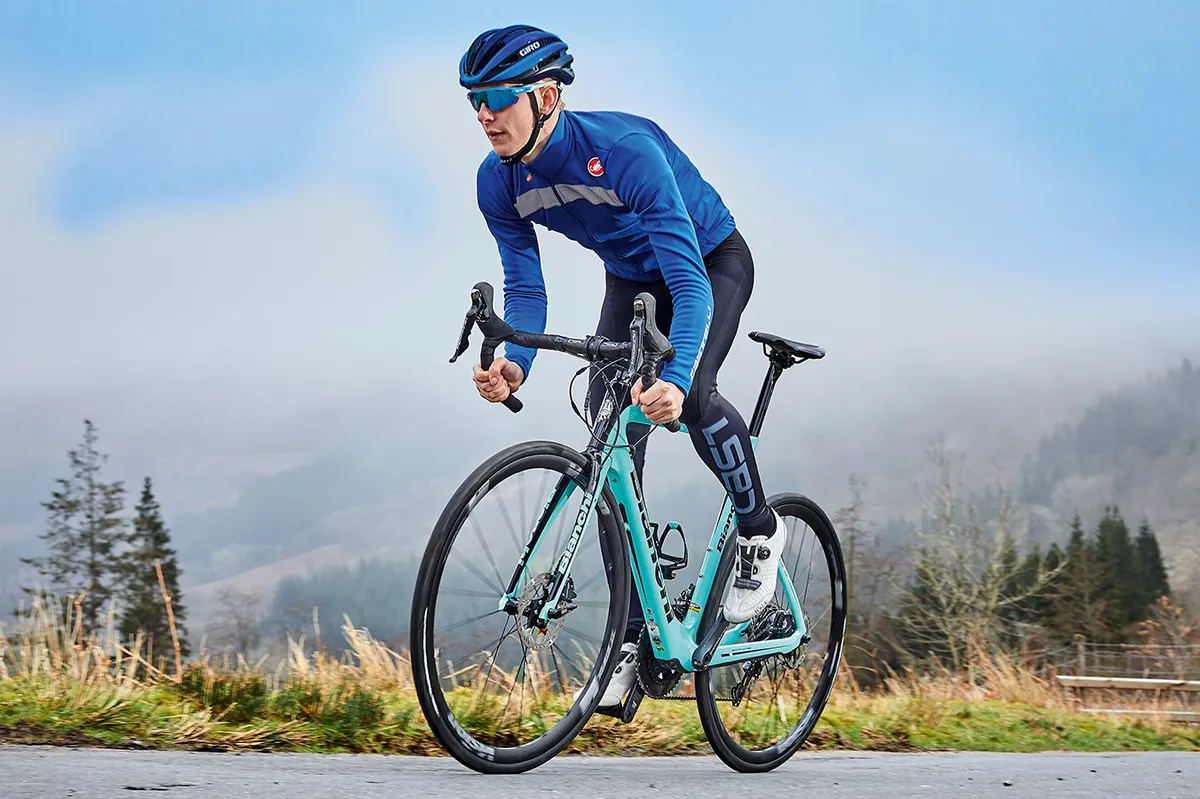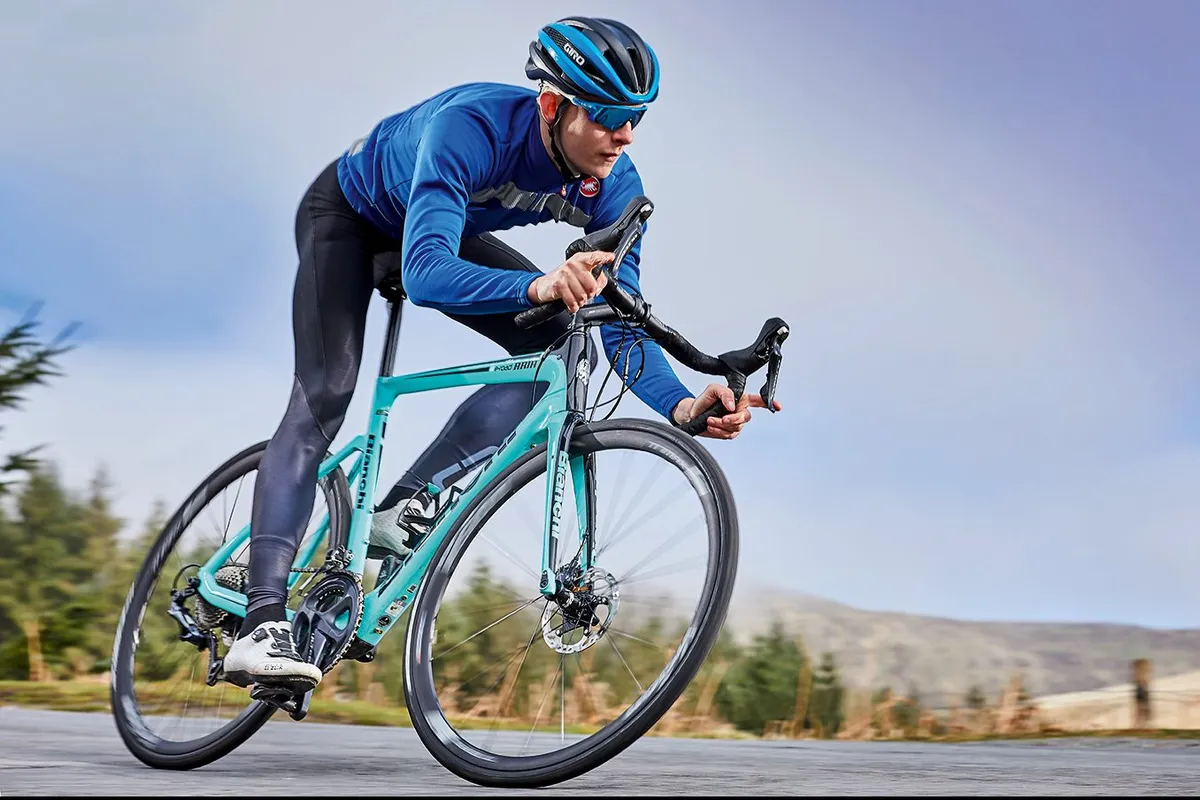The Aria’s powerful shape and aero-optimisation make it a favourite for speed merchants, so it was a surprise that Bianchi used the Aria chassis as the basis for one of its two electric road bikes.
Inside the Aria’s substantial down tube is sandwiched a 250-watt battery (some Enduro-batteries you’ll find on the burgeoning e-mountain bike market can be double that), so I’ve ridden the Aria to empty to see how much assistance that gives you and for how far.

I’ve tried the ebikemotions system before on the excellent gravel-focused Orbea Gain D15, but on the Aria it’s the latest X35 V2 hub motor.
The system is controlled by its iWoc button mounted on the top tube, and it’s a simple process to operate: press the top tube button to turn it on and the LED-lit ring around the button shines white. Press and hold and it turns green (low assistance), orange (medium), red (full).
This is also the battery level indicator: white is 100–75 percent; green 75–50 percent; Orange 50–25 percent; red 25 percent; flashing red is less than 10 percent.
It’s also Bluetooth enabled and the controller flashes blue as it connects to your phone via the ebikemotion app, which shows battery level, distance travelled, altitude, average speed, cadence, gradient and current speed.
The elephant in the room with any e-road bike is EU legislation that limits the assistance to 15.5mph, after which the motor stops helping (the EU law does allows a 10 percent margin).
On the Aria, however, the assistance only kicks in when the road starts to rise, so on normal flat or rolling roads it feels, well, like an Aria: it’s fast, it holds onto speed well and it handles like an aero bike should, while the slightly relaxed head angle means it’s stable and smooth riding (thanks to those big 28c tyres).
It’s heavier than a standard Aria – the Aria Potenza Disc was 8.58kg but the extra 3.72kg isn’t an issue until you head upwards or sprint off the line. In both instances the addition of e-power equalises the disadvantage.

On my first ride out I achieved 76.7 miles / 123.43km until the battery ran down, with 1,222.2m / 4,009.84ft of climbing at an average speed of 16.98mph.
I boxed clever, using assistance to the max when needed and reducing it to a minimum (or off) when not. The Aria simply works well as a bike, it just happens to have a 250-watt boost, and the ebikemotion system is a much subtler level of powered assistance.
It’s based on one of Bianchi’s more aggressive designs (I would have expected it to be built around the more endurance-biased Infinito or Sempre) and with its 556mm stack and 395mm reach on my 57cm test bike, when you’re riding you feel like you are piloting a racy aero bike (you pretty much are).
The Shimano Ultegra drivetrain with its pro-compact 52/36 and 11-30 cassette adds a bit of speedy kudos and, as it’s Ultegra, it works well every time; the Ultegra disc brakes offer enough power and feel to arrest the extra weight of this e-motor and battery.
The tyres, bigger than you find on the standard Aria (28s compared to 25s), mean great ride quality over rougher surfaces, even though I ran higher pressures to counter the extra mass.
The Vision wheels are smooth and true, as is the Bianchi Reparto Corse branded hardware (which like the Vision wheels come from the FSA stable). Some of the components are a little on the cheap side for a £4,500 bike, but factor in the cost of a full e-bike system, and the extra engineering in making a frame that can handle it, and it’s on the ball for the money.
Bianchi Aria E-Road specifications
- Sizes (*tested): 47, 50, 53, 55, 57*, 59, 61cm
- Weight: 12.3kg
- Frame: Carbon
- Fork: Carbon
- Chainset: Shimano Ultegra
- Bottom bracket: Shimano
- Chain: Shimano Ultegra
- Derailleurs: Shimano Ultegra
- Shifters: Shimano Ultegra
- Wheelset: Vision Trimax alloy disc with Ebikemotion motor unit rear hub
- Tyres: Vittoria Rubino 28c
- Stem: Bianchi Reparto Corse stem and bar
- Bar: Bianchi Reparto Corse stem and bar
- Saddle: Selle Royal SL
- Seatpost: Bianchi Reparto Corse carbon
- Brakes: Shimano Ultegra hydraulic disc
- Motor: 250W rear hub motor unit, 250Wh integrated battery and iWOC One remote control
Bianchi Aria E-Road geometry
- Seat angle: 73.5 degrees
- Head angle: 73 degrees
- Chainstay: 41cm
- Seat tube: 57cm
- Top tube: 56cm
- Head tube: 15.5cm
- Bottom bracket drop: 6.8cm
- Wheelbase: 993mm


